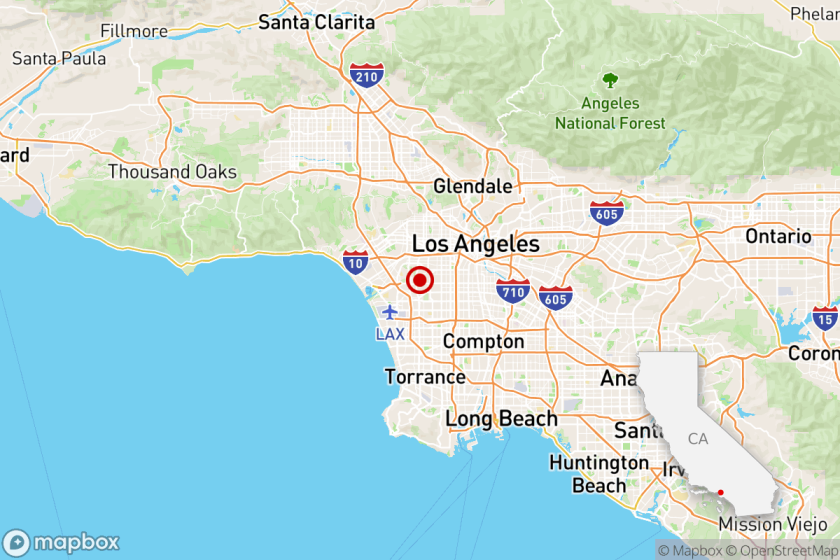Development on the fly
THE CONTROVERSY OVER selling “air rights” above the Convention Center as development credits that could be used to build high-rise housing downtown underscores Los Angeles’ fragmented, often incoherent approach to land use,
planning and development. The air-rights proposal, which was vetoed by Mayor Antonio Villaraigosa, isn’t a bad idea in concept. Indeed, the mayor said as much in his veto explanation. But the City Council passed the ordinance without having first achieved a political consensus among city officials or private interests -- and without any thoughtful consideration of how the new construction would affect downtown, let alone the rest of the city. Regrettably, incidents like this make the city seem like a small town rather than the world-class metropolis it aspires to be.
But it’s not too late to set a new course that will guide the city’s development for the next generation. Villaraigosa supports what he calls “elegant density,” and the city has a new planning director.
There have been many attempts at creating a long-range vision of how the city should develop. As far back as 1930, a group of architects led by Frederick Law Olmstead, the designer of New York’s Central Park, came up with a plan to make parks, plazas and transit routes accessible throughout the city. The ideas were largely ignored.
In the 1960s, as the postwar development boom was cresting, the city Planning Department rallied behind the idea of a series of urban centers across Los Angeles that would be connected by major streets and public transit lines. Some centers -- Century City, for one -- were developed, but the connections were never established.
In the mid-1980s, voters worried about uncontrolled growth and traffic congestion passed an initiative drastically reducing development opportunities in most of the city’s commercial areas. But the law effectively pushed commercial development to the fringes of the city and further politicized the development approval process.
In the early 1990s, city officials promoted an early version of what is now called “new urbanism”: higher-density, mixed-use (commercial and residential) and pedestrian-friendly development. The idea produced little enthusiasm. Five years ago, largely in response to the San Fernando Valley’s secessionist movement, the city established a system of neighborhood councils to weigh in on land use in their respective areas. But these councils have little incentive to think or act on behalf of the city as a whole.
As a result, L.A. lurches from one land-use crisis to another. Despite the General Plan, which is supposed to guide development citywide, land-use issues are fought out one at a time. The Valley and downtown businesses argue over how much -- or even if -- city resources should be committed to the Grand Avenue project. Manufacturers clash with residential developers over the fate of the old industrial core downtown between Main Street and the Los Angeles River. Eastside and Westside battle over where scarce transit dollars should be spent. City officials bemoan soaring housing costs but cannot rally public support to fund affordable-housing programs. Public schools in parts of the city remain overcrowded, but many neighborhoods don’t want a new campus in their backyard. Obtaining city approval for development projects has become so complex that an industry of lobbyists and facilitators has sprung up to navigate the bureaucracy.
The current system of land-use regulation influences growth only in small ways. The city’s population continues to rise, but its infrastructure capacity -- streets, schools, parks, water systems -- grows only incrementally, if at all. No wonder that many residents, weary of traffic, noise, potholes, crime and smog, have become classic NIMBYs dedicated to getting as large a share of public resources for their neighborhoods as possible, while keeping out the effects of living in a big city.
This will not change until all of L.A.’s diverse communities believe their futures are inextricably linked. To that end, residents and their leaders must agree on what kind of city Los Angeles is. This consensus could be the foundation for developing a vision of what the city should be in 20, 30 or even 50 years. As important, it could be the basis of a guide on how L.A. should interact with the rest of the region on issues that transcend any one jurisdiction.
The city doesn’t have to reinvent the planning wheel to accomplish this. Other parts of the country can provide some valuable guidance. In Utah, a regional planning program, dubbed Envision Utah, has steered growth away from sprawl toward more compact development of the entire Salt Lake City area. Chicago’s Metropolis 2020, born out of business’ concern over a deteriorating quality of life in the city, led to the creation of a more comprehensive and inclusive planning process. In California, San Diego recently completed a citywide effort at public participation under Gail Goldberg, L.A.’s new planning director, that produced the City of Villages plan -- stimulating growth, especially mixed-use development, where people are already congregated and along transit corridors.
Here’s what L.A. needs to do:
* The mayor and City Council must embrace a development process for the city that transcends political and neighborhood boundaries and focuses on the long-term needs of L.A. as a whole.
* To engage the public, meetings, workshops, education programs and planning exercises should be held throughout the city, preferably by an entity or person unconnected to the city’s current land-use system. Out of this process should emerge a number of alternative long-term scenarios that reflect residents’ overarching values and goals. With voters watching closely, city officials would select the best development path. The winning scenario would provide direction for city planners in deciding where to build, say, affordable housing, route public transit and locate schools, parks and police stations.
* The city’s formal planning documents need to be updated and revised to reflect the results of the public engagement described above.
As the saying goes, if you don’t know where you are going, any path will do. That is Los Angeles’ current situation. Instead, the city must create a citywide plan. A good place to start is to rethink how selling the air rights over the Convention Center might better rationalize L.A.’s growth.
More to Read
Start your day right
Sign up for Essential California for news, features and recommendations from the L.A. Times and beyond in your inbox six days a week.
You may occasionally receive promotional content from the Los Angeles Times.






